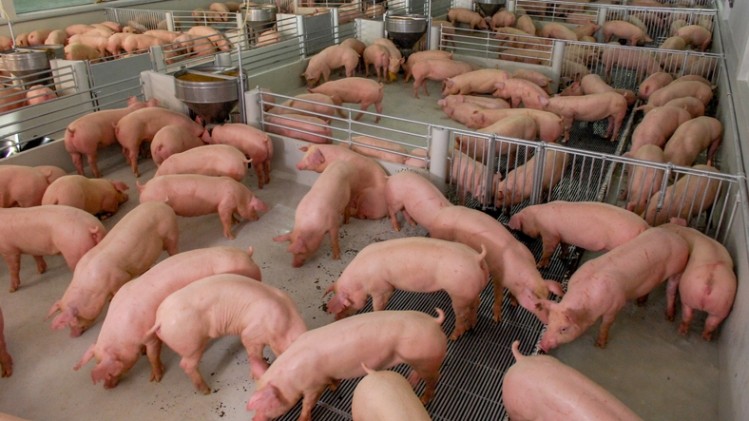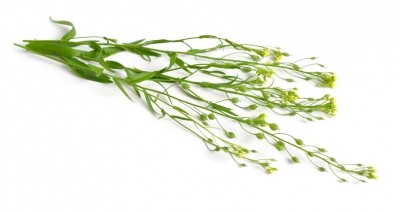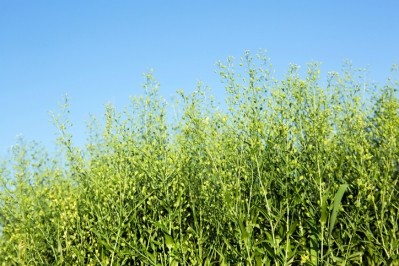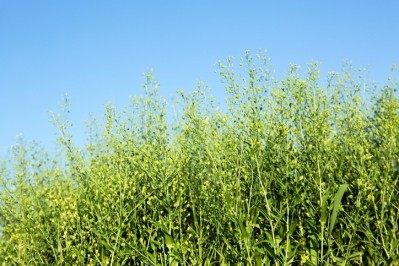Camelina cover-crop use may support pig growth, soil health

Researchers at the University of Minnesota, Minnesota Extension and the USDA’s Agricultural Research Service (ARS) explored the potential for producers to raise the oilseed camelina to provide a cold-weather cover crop and feed ingredient for swine.
The project grew out of an interest in organic production, alternative production systems for swine and use of camelina, said Lee Johnston, professor of swine nutrition and management and director of operations at the West Central Research and Outreach Center with the University of Minnesota.
Camelina, as a cover crop, could be raised to address soil health issues and still provide a usable feed ingredient for swine producers.
“This first study was to dial in on what levels could we feed and wanting to use as high a level as possible,” he told us.
Work on a follow-up research project using camelina in swine diets is already in progress, he added.
“We did this first study, and we are raising some camelina at the [West Central Research and Outreach] Center this year,” he said. “We’ll harvest that and follow on with a larger study using 10% in the diet and more pigs and looking at carcass quality and eating experience.”
The feeding study was supported by a grant award from the USDA's National Institute of Food and Agriculture regarding the Organic Transition Program.
Cover crop use and feeding camelina
Feed crop producers have to adjust production practices to address changing market forces, social pressures and improve sustainability, the study authors said. One practice gaining interest in the use of winter cover crops.
Planting a cover crop in the fall can protect topsoil from wind and water erosion during the period from fall harvest until new crops are established in the spring, they said. However, they also may increase costs from seed use, tillage and planting.
Cover crops might be more interesting for producers if some of the expense could be recovered in the short-term, along with the long-term benefit of improved soil, the researchers said. Winter camelina could be one cover crop that provides those qualities.
The oilseed can be planted in the fall and generates seed in the early summer, which can be used to produce oil and a high-protein meal, they added.
There may, however, be some challenges using camelina meal in swine diets as the feed ingredient can contain levels of anti-nutritional factors, like glucosinolates and erucic acid, and sometimes has a bitter taste, said Johnston.
The amino acid concentration also is not quite as high as it is in soybean meal and less is known about how digestible the amino acids in the meal may be, he said. “When we formulated these diets we … had to make our best guess on digestibility and that doesn’t allow you to dial in the diets as tightly as you could do with some of the other meals we have more information on,” he added.
Feeding trial overview
In the swine feeding trial, 192 grow-finish stage pigs received one of four diets as they matured from about 75lbs to 270lbs, the researchers said.
The diets included 0, 5, 10 or 15% camelina meal, they said. Camelina meal contains more protein than cereal grains like corn but is lower in protein and lysine than soybean meal so it can only be used as a partial replacement.
During the feeding trial, swine were examined for growth performance, they said. Following the trial, all pigs were checked for carcass quality and a selection was examined for the quality of the pork produced.
Results and continuing research
Going into the feeding trial there was an anticipation that there could be a drop in feed intake and a corresponding fall in daily weight gain, said Johnston.
Average daily gain was about 5% lower for pigs on the camelina diets, however, there was only a slight trend in reduced feed intake for pigs on the trial diets, the researchers said. Lean meat content on the carcasses was similar for pigs on all diets and meat quality indicators including drip loos in loin chops, loin pH, quality of pork belly and chop marbling score.
Pigs on the camelina feeds were slightly lighter at the end of the feeding trial, said Johnston. The loin area was slightly different and back fat was a little lower.
However, adding three or four days to feeding times may matter less in an organic production system than it would in a conventional production setup, he said. “Most of the organic systems that I’m aware the time factor is not as important,” he added.
Organic and specialty producers may be more likely to use direct sales or different marketing methods, he said. There also could be a benefit if the feed using camelina were less expensive, but that could depend on an individual producer’s economic situation.
The upcoming feeding trials will use a completely organic diet and follow pigs through to market, Johnston said. But one that is formulated in the same manner as the current product.
Title: Feeding Camelina Meal to Pigs
Authors: L. Johnston, Y. Li, A. Hilbrands, R. Cox, W. Lazarus, W. Martin, F. Forcella, and R. Gesch












